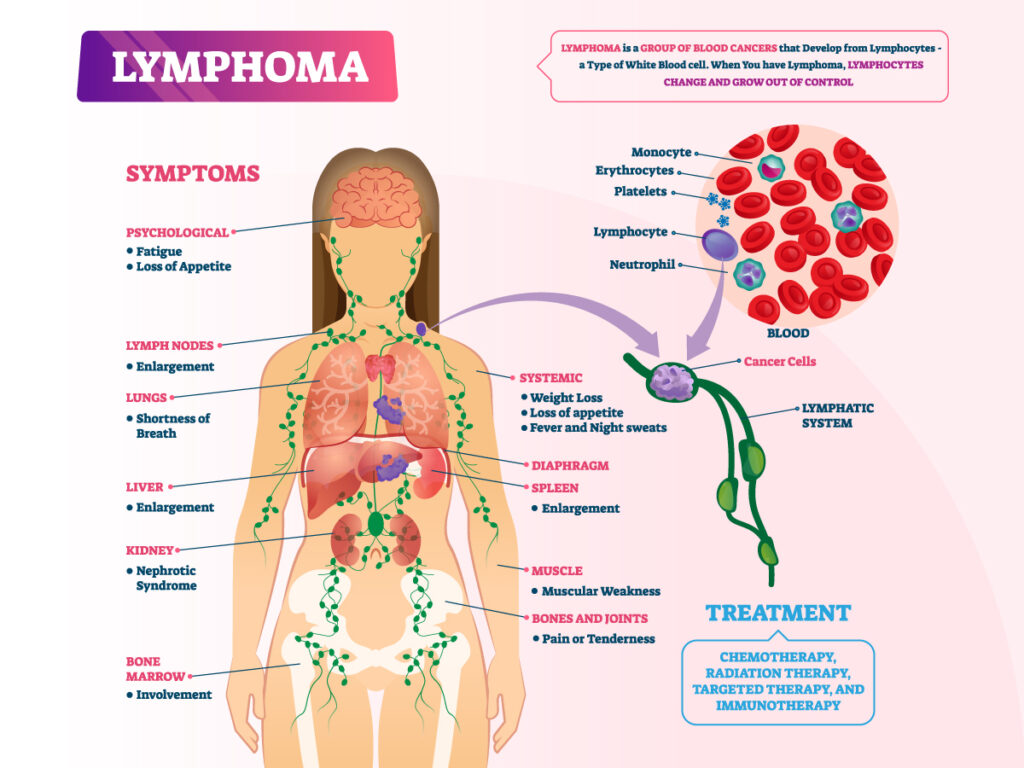Whether it’s Hodgkin’s or non-Hodgkin’s, lymphoma Is one of the most treatable forms of cancer. With a relatively high 5-year survival rate, people affected by lymphoma tend to fare well compared to those with other types of cancer.
Still, some cases of lymphoma can be very serious. Especially at advanced stages, they can lead to irreversible complications and turn fatal. If you or a loved one have recently been diagnosed with lymphoma, you likely have a lot of questions about the nature of the disease and how it will impact your health.
Read on to learn more about how lymphoma affects the body, the complications it can cause, the symptoms of dying from lymphoma, and how palliative and hospice care can supplement your treatment and enhance your quality of life.
Are you or a loved one living with a chronic or terminal illness?
The Sage Family of Companies is here to help.
Are you or a loved one living with achronic or terminal illness?
The Sage Family of Companies is here to help.
What Is Lymphoma?
Lymphoma is a type of cancer that affects the lymphatic system: the network of tissues and organs that protects the body from infections. The lymphatic system includes the bone marrow, spleen, thymus, lymph nodes, and lymphatic vessels. There are two types of lymphoma: Hodgkin’s and non-Hodgkin’s.
- Hodgkin’s lymphoma, formerly known as Hodgkin’s disease, spreads from one group of lymph nodes to another in an orderly manner.
- Non-Hodgkin’s lymphoma, which is more common, spreads through the lymphatic system in a non-orderly fashion.
Symptoms of End Stage Lymphoma
The symptoms of end-of-life lymphoma can vary depending on the affected organs. In the advanced stages, the symptoms of lymphoma worsen, including swelling of the lymph nodes, fatigue, night sweats, recurrent fever, pain, shortness of breath, nausea, vomiting, constipation, and itchy skin.
When death from lymphoma draws near, you or your loved one may experience:
- Loss of appetite
- Extreme fatigue and tiredness
- Trouble breathing
- Confusion
- Severe pain
- Withdrawal from others
- Feeling cold
- Incontinence
In general, signs of the final days of life include:
- An irregular pulse
- A drop in body temperature and blood pressure
- Irregular breathing or gasping for air
- Mottled skin that’s blue or purple in color

How Lymphoma Can Lead to Death
The medical community generally considers lymphoma to be very treatable. In fact, Hodgkin’s lymphoma is widely recognized as one of the most treatable forms of cancer.
Still, both Hodgkin’s and non-Hodgkin’s lymphoma can advance to severe stages and lead to death. Sometimes, death results from disease progression and has no specific cause. Other times, the complications from lymphoma cancer lead to death. These complications include infections, organ damage or failure, and bleeding.
Infections
One of the main roles of your lymphatic system is to fight off germs from your body and protect it from infection. Lymphoma cancer can prevent this important function.
Lymphoma occurs when white blood cells, also known as lymphocytes, mutate and grow out of control. The more cancerous lymphoma cells you have, the less room there is for healthy, germ-fighting white blood cells to form.
A shortage of white blood cells increases the risk of infections, including respiratory infections like pneumonia and bloodstream infections like sepsis. These infections can become very serious and can quickly turn fatal.
Organ Damage and Failure
Lymphoma that spreads to other organs in the body is known as stage 4 lymphoma. The cancer may spread to the liver, lungs, and bone marrow. As it progresses, it can damage these organs. When that happens, they may no longer function properly to keep you healthy.
Your liver, for example, is responsible for removing waste products from your body. But toxins can build up in the blood when cancer disrupts this process. Over time, this can be life-threatening. Lymphoma that affects the lungs can lead to respiratory issues and infections that can turn deadly.
Bleeding
Lymphoma that invades the bone marrow can cause thrombocytopenia, a condition where your body doesn’t have enough platelets (healthy blood cells that clump together to form a clot) to stop bleeding.
In severe cases of thrombocytopenia, you may not have enough platelets to stop internal bleeding, such as bleeding in the gut, which can lead to death. Additionally, while rare, thrombocytopenia can lead to bleeding in the brain, which can cause a stroke.
Prognosis for Lymphoma Patients
The life expectancy for lymphoma depends on the type, severity, and the organs that are affected. In general, people with Hodgkin’s lymphoma have better outcomes than those with non-Hodgkin’s lymphoma, but both forms of cancer are considered very treatable.
The five-year survival rate for Hodgkin’s lymphoma is 89 percent. This means that 89 percent of individuals with this cancer will still be alive five years after diagnosis. The five-year survival rate for non-Hodgkin’s lymphoma is just over 74 percent.
Keep in mind that survival rates aren’t set in stone, but are estimates based on outcomes from a large number of people with the disease. Your doctor will closely monitor your cancer and discuss treatment options and your individual prognosis.
Are you or a loved one living with a chronic or terminal illness?
The Sage Family of Companies is here to help.
Are you or a loved one living with achronic or terminal illness?
The Sage Family of Companies is here to help.
FAQ
Here are answers to the most frequently asked questions about the symptoms of dying from lymphoma.
At What Stage is Lymphoma Terminal?
Lymphoma often becomes terminal at stage 4. During this stage, it has spread to further areas of the body, such as the liver, lungs, or bone marrow. This is considered the most advanced form of lymphoma and can lead to complications that can turn fatal, including serious infections and liver damage.
However, stage 4 lymphoma isn’t always terminal. The 5-year survival rate for advanced lymphoma is 58 to 87 percent, depending on the form.
How Fast Does Lymphoma Worsen?
The speed at which lymphoma worsens depends on the type and where it’s located in the body. Low-grade types of lymphoma, also known as indolent lymphoma, tend to grow slowly and often don’t require treatment right away. Aggressive, or high-grade, lymphomas tend to grow and spread quickly.
Doctors often recommend treatment for these types of lymphoma soon after diagnosis. However, even though high-grade lymphoma spreads quickly, it’s often responsive to treatment.
Deciding When to Stop Treatment for Lymphoma
Making the decision to stop lymphoma treatments is a very personal one. Sometimes the body stops responding to cancer drugs. If your care team has exhausted all options, your doctor may advise you to stop treatment. Some patients may choose to stop their treatment on their own if the side effects from cancer drugs like chemotherapy are making them too unwell and affecting their quality of life.
Whatever the reason, stopping cancer treatment can be an emotional and difficult decision. Your doctor will discuss the risks and benefits of stopping treatment. They will also explain the likelihood of whether further treatment may work so that you can make the right decision. If and when you decide to stop treatment, know that there are options available to control your symptoms and make you comfortable.
Palliative and Hospice Care for Lymphoma
If you or a loved one has lymphoma, you may want to consider palliative care. This is a specialized form of care that supplements medical care for people living with chronic diseases like cancer. The purpose of palliative care is to provide comfort and improve quality of life while you’re undergoing treatment.
Palliative Care
A palliative care team consists of doctors, nurses, specialists, social workers, dietitians, and spiritual advisors such as chaplains. They all work together to ease your pain and other lymphoma symptoms while at the same time addressing your mental, emotional, and, if desired, spiritual health.
Palliative care doesn’t mean you stop receiving treatment meant to stop or cure your cancer. Think of palliative care more as care for the whole person. You’ll continue to receive treatments for your lymphoma, but will also be able to receive additional care focused on your overall well-being.
Hospice Care
If medical treatment stops working or your lymphoma complications become too severe to manage, it’s time to consider hospice care. This type of care aims to manage symptoms and enhance comfort as you and your family await what’s to come.
During hospice care, you’ll no longer receive curative treatment, and the focus will shift towards easing your pain and making preparations to transition out of life. This can be an extremely emotional and difficult time for the whole family and your hospice care team will provide resources and emotional support for you and your loved ones every step of the way. You’ll be able to receive hospice care at home or at a hospice facility.
Summary
While lymphoma is considered a highly treatable form of cancer, severe forms can cause serious complications like infections, organ damage, and bleeding, and turn fatal. Both palliative and hospice care can help you and your family manage your illness, bring you comfort, and enhance your quality of life, regardless of what stage it’s in.
The Sage Family of Companies is here to answer any questions you may have.






